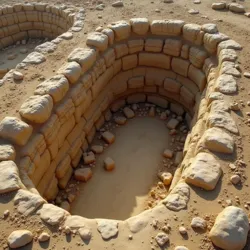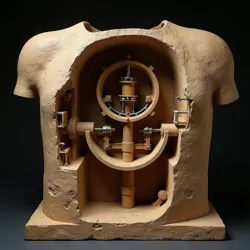Yammuneh Torso

The central resonance chamber of the Yammuneh Torso during excavation
1998
Yammuneh, Lebanon
c. 7200-6800 BCE
Pre-Halafian
Limestone and basalt
4.2m x 3.8m x 5.1m
42% intact
Overview
The Yammuneh Torso is a remarkably preserved central section of an ancient Megalithomaton discovered in the Beqaa Valley of Lebanon. Dating to approximately 7200-6800 BCE, this archaeological find represents one of the most significant examples of Pre-Halafian mechanical engineering yet discovered. The specimen derives its name from both its location near the modern village of Yammuneh and the fact that it primarily consists of the torso section of the original construct, including crucial internal mechanical components.
The discovery of the Yammuneh Torso in 1998 marked a significant expansion of the known geographical range of Megalithomaton construction, suggesting that the technological and cultural influence of the Pre-Halafian civilization extended further south than previously believed. Its unique architectural features and preservation state have provided invaluable insights into the internal workings of these ancient mechanical constructs.
Physical Description
Structure and Composition
The Yammuneh Torso consists primarily of carefully worked limestone blocks with strategic basalt reinforcements at key structural points. The preserved section measures approximately 4.2 meters in height, 3.8 meters in width, and 5.1 meters in depth, representing roughly 42% of what would have been the central portion of a complete Megalithomaton. The construction demonstrates sophisticated understanding of Geometric Harmonic Design, particularly in the precise angular relationships between internal chambers.
The outer shell exhibits remarkable preservation of the original surface treatments, including traces of geometric patterns that align with known examples from other Megalithomaton sites. These patterns appear to have served both decorative and functional purposes, with some researchers suggesting they may have acted as calibration markers for the construct's movement systems.
Internal Mechanisms
 Detailed view of the preserved mechanical linkages within the primary resonance chamber
Detailed view of the preserved mechanical linkages within the primary resonance chamberThe most significant feature of the Yammuneh Torso is its exceptionally well-preserved internal resonance chamber, which provides the clearest evidence yet documented of how these ancient machines achieved controlled movement. The chamber incorporates a series of precisely carved channels and chambers that appear to have utilized principles of acoustic amplification and mechanical resonance to facilitate movement of the larger structure.
Archaeological Significance
Excavation History
The initial discovery of the Yammuneh Torso occurred during an agricultural development project in 1998. The systematic excavation that followed, led by the Institute of Prehistoric Technologies, took place over six seasons between 1999 and 2004. The careful documentation of the site has provided unprecedented insights into Megalithomaton construction techniques and operational principles.
Technical Innovations
The Yammuneh Torso exhibits several unique technical features not previously observed in other Megalithomaton remains. Most notably, the integration of water management systems within the resonance chamber suggests a more sophisticated approach to movement control than that seen in earlier examples. This has led some researchers to propose that the Yammuneh installation represents a later, more advanced stage of Megalithomaton development.
Research Impact
Engineering Analysis
Detailed study of the Yammuneh Torso has revolutionized understanding of Pre-Halafian engineering capabilities. The precision of the stone-fitting techniques and the complexity of the internal mechanical systems have required scholars to significantly revise previous assumptions about Neolithic technological achievements. The specimen has become a cornerstone of research in the field of Archaeo-mechanics, providing tangible evidence of sophisticated mechanical principles in use thousands of years earlier than previously thought possible.
Cultural Implications
The presence of such an advanced mechanical construct in the Beqaa Valley has important implications for understanding the spread and development of Pre-Halafian technology. The Yammuneh installation suggests the existence of a more extensive network of technological knowledge transfer than previously recognized, challenging existing models of cultural development in the ancient Near East.
Conservation and Display
The preservation efforts for the Yammuneh Torso represent one of the most ambitious archaeological conservation projects in Lebanon. A purpose-built structure now protects the remains while allowing continued research access and limited public viewing. The site has become a crucial center for the study of ancient mechanical systems, attracting researchers from various disciplines including engineering, archaeology, and materials science.
Legacy
The Yammuneh Torso continues to influence modern understanding of prehistoric engineering capabilities. Its study has contributed significantly to the development of the Karahan Paradigm, which proposes a more complex model of technological development in human civilization. The specimen remains one of the most important pieces of evidence for advanced mechanical knowledge in the Neolithic period, challenging traditional narratives about the development of human technological capabilities.
See Also
- Yammuneh Installation
- Geometric Resonance Chambers
- Stone Activation Ceremonies
- Neo-Megalithic School
References
The documentation and analysis of the Yammuneh Torso has generated numerous academic publications and technical studies, establishing it as a cornerstone reference for research into ancient mechanical systems and Pre-Halafian engineering capabilities. Its ongoing study continues to yield new insights into the technological achievements of our ancient ancestors.